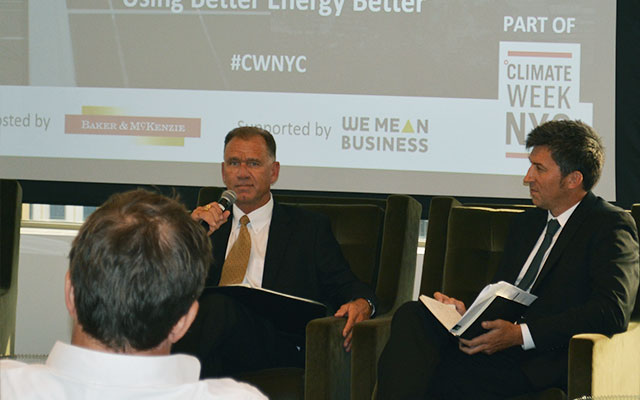Danfoss, a leading manufacturer of high-efficiency components and controls for air-conditioning, heating, refrigeration, industrial, and water systems, this week joined Climate Week — the eighth annual event hosted by The Climate Group to drive climate action — in a panel discussion to explore the opportunities and barriers to the clean energy transition.
Opened by Rachel Kyte, CEO of Sustainable Energy for All, the event convened representatives from companies who have signed on to The Climate Group and We Mean Business’ RE100 or EP100 initiatives to lead the energy transition through new, innovative technologies and business models. Companies that joined RE100 have made a commitment to switch to 100 percent renewable power; companies that joined EP100 have made a commitment to double energy productivity and are choosing smarter energy use to maximize business value.
John Galyen, president, Danfoss North America, said, “Doing business as usual is no longer sufficient. The way to meet the UN’s Sustainable Development Goal Seven and ensure access to affordable, reliable, and sustainable energy is through energy productivity — creating more economic output from each unit of energy.”
“Globally, the energy productivity increased at an average 1.3 percent per year worldwide between 2001 and 2011. But this improvement is not enough to keep pace with the increasing demand for energy, which causes us to deplete natural resources at a staggering rate. Nearly 98 percent of all energy we use in the process of production is wasted rather than being converted into useful services and products. Doubling energy productivity would reduce the global fossil fuel bill by more than $2.2 trillion and could create more than six million jobs globally by 2020. Doubling energy productivity in the US alone by 2030 will save $327 billion a year in energy costs, create 1.3 million jobs, and reduce CO2 emissions 33 percent by 2030.”
Commitment to smart energy use
Earlier this year at the Alliance to Save Energy’s Energy Efficiency Global Forum, Danfoss pledged to join the EP100 initiative.
Since 2007, Danfoss has improved its energy productivity by 60 percent through energy-saving projects in its 21 largest factories accounting for 70 percent of the company’s total energy consumption. More than 160 technical projects have been identified, in which Danfoss uses its own products to increase energy productivity and efficiency, all with a maximum payback time of three years.
For example, Danfoss drives are being installed to adjust the number of revolutions on fans and pumps; Danfoss heat exchangers are being fitted to recover the heat from compressed-air systems; and a wide range of adjustment valves, temperature sensors, and pressure transmitters are also in use to drive down energy consumption.
Facts:
- Danfoss has saved $2.3 million through efficiency measures within ventilation systems, reducing its global energy consumption by 3.8 percent.
- By optimizing heat distribution and recovery in its Denmark-based headquarters, Danfoss has reduced its heating costs by $400,000.
- Globally, Danfoss has invested $21.2 million into energy-efficient measures that are projected to save an estimated $7 million on energy costs annually.
“The single biggest opportunity to double energy productivity comes from optimizing the building stock which consumes 40 percent of energy,” Galyen explained. “Looking at the whole building system and focusing on smart and connected buildings is critical. Proven technologies like variable speed and district energy are currently under-deployed, but the optimization of technical building systems is common sense. These systems benefit building occupants and are easy to implement, capital light, bring fast payback, and are not invasive.”
Other speakers during the Climate Week event included representatives from General Motors, Mahindra & Mahindra, Wells Fargo, US Department of State, American Council on Renewable Energy, and We Mean Business.
Climate Week NYC 2016 gathered leaders from business and government to demonstrate how continued investment in innovation, technology, and clean energy will drive profitability and lead us toward net zero emissions.





Comments